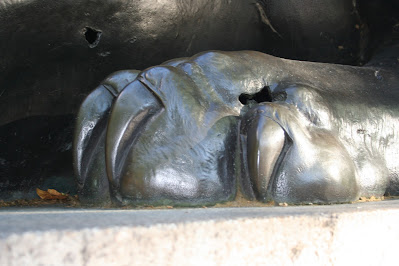What is the link that unites these six degrees of separation:
- a tattoo,
- a cage,
- a massive flak tower,
- the body of a queen,
- a desert find in 1912,
- and a lost monarchy?
The tattoo is a quote from Tennessee Williams: A prayer for the wild at heart, kept in cages.
The cage is the one in the tattoo, and a Berlin bullet proof cage.
The flak tower is the one near the zoo in Berlin, built during the Second World War to protect the city from British, French and American bombers.
The body of a queen is The Body of the Queen: Gender And Rule in the Courtly World from the 15th to the 20th Century, the English translation published in 2006.
The desert find in 1912 is the discovery under the hot desert sands of Armana by the German Egyptologist, Ludwig Borchardt, of the bust of Nefertiti, the beautiful queen of ancient Egypt.
The lost monarchy is the royal family which ruled Germany until the last monarch, Kaiser Wilhelm II, was forced to abdicate after Germany's defeat in the First World War.
And the link is the professor with a 1996 Ph.D. in German Literature from Humboldt University, Berlin, who wrote, among other things, the article entitled Digital Digs, or: Lara Croft replaying Indiana Jones. Archaeological Tropes and ‘Colonial Loops’ in New Media Narrative.
Meet Professor Doctor Claudia Breger, the Associate Professor of Germanic Studies, Indiana University.
 |
| Professor Claudia Breger |
Breger is the author of the chapter in The Body of the Queen entitled The ‘Berlin’ Nefertiti Bust: Imperial Fantasies in Twentieth-Century German Archaeological Discourse.
Lara Croft is the fictional heroine of the very successful video game Tomb Raider.
Beautiful, intelligent and very fit, Lara is an archeologist – similar to the Indiana Jones character – who faces countless hazards in her exploration of tombs and ruins around the world.
Lara's trademark costume is a sleeveless tank top, calf-high boots, fingerless gloves, and two pistols thrust into holsters attached to her utility belt.
The tattoo is the one of the thirteen which Angela Jodie has, and is the one she and her mother each had done in a mother-daughter bonding moment.
Angela Jodie as a female action star received a major boost when she starred as Lara Croft in the movie Lara Croft: Tomb Raider, beating out Pamela Anderson and Demi Moore for the role.
 |
| Lara Croft |
One of the Berlin Museum officials we spoke to said that the Nefertiti bust deserved to stay in Berlin rather than being returned to her homeland, Egypt, because she was an outstanding example of how the foreign can be integrated into society.
In her article, Claudia Breger puts her finger on the real reason why the German governments have refused for 90 years to allow the bust of Nefertiti to return to Egypt.
She mentions an offer in the 1930's to exchange the bust of Nefertiti for a collection of other Egyptian objects; James Simon, the man who bankrolled the expedition of Ludwig Borchardt which discovered the bust in 1912, supported the exchange, because, he said the "unanimous judgment of the real experts" was that the objects offered in exchange were more valuable than the Nefertiti bust.
The exchange never took place, and many Germans flocked to see Nefertiti in the Berlin museum when word of the exchange leaked out.
What has made the bust of Nefertiti such a revered object for ordinary Germans, as well as those German officials who have a say over her continued stay in the country?
Claudia Breger says that Nefertiti has achieved "star" status, and simply put, is a surrogate for the monarchy which Germany lost after the First World War.
She writes:
The bust is thus exhibited [in her cage on the raised pedestal in the Berlin museum] as the royal object of a modern cult... The newspapers from 1930 were aware of the potential inherent in such figures of royal stardom, and thus the (image of) Nefertiti became the new monarch for the people of the Weimar Republic who had just been 'robbed' of their emperor.
Thanks to Claudia Breger for explaining just why the German government and museum authorities are so insistent on keeping the bust of Nefertiti.
Their arguments might be based on the legality of the acquisition when Ludwig Borchardt divided up the spoils of his excavations with Egypt, but we feel that the officials protesteth too much.
 |
| Nefertiti bust in Berlin New Museum 2009 |
Now, with Claudia Breger's explanation as our guide, we understand why Chancelor Angela Merkel is intent on keeping the Nefertiti bust behind the bullet proof glass of its brand new cage in the New Museum of Berlin.
Nefertiti has been co-opted by Germany as the queen they no longer have.
Kaiser Wilhelm II might have in his study in his place of exile in Holland a copy of the bust made in 1913 for him by James Simon, but Germany has in its new museum in Berlin a copy of their replacement royalty: Nefertiti, Queen of Germany, hidden in a flak tower in Berlin in 1941 to protect Her Majesty from the bombing raids of the Allies.











































